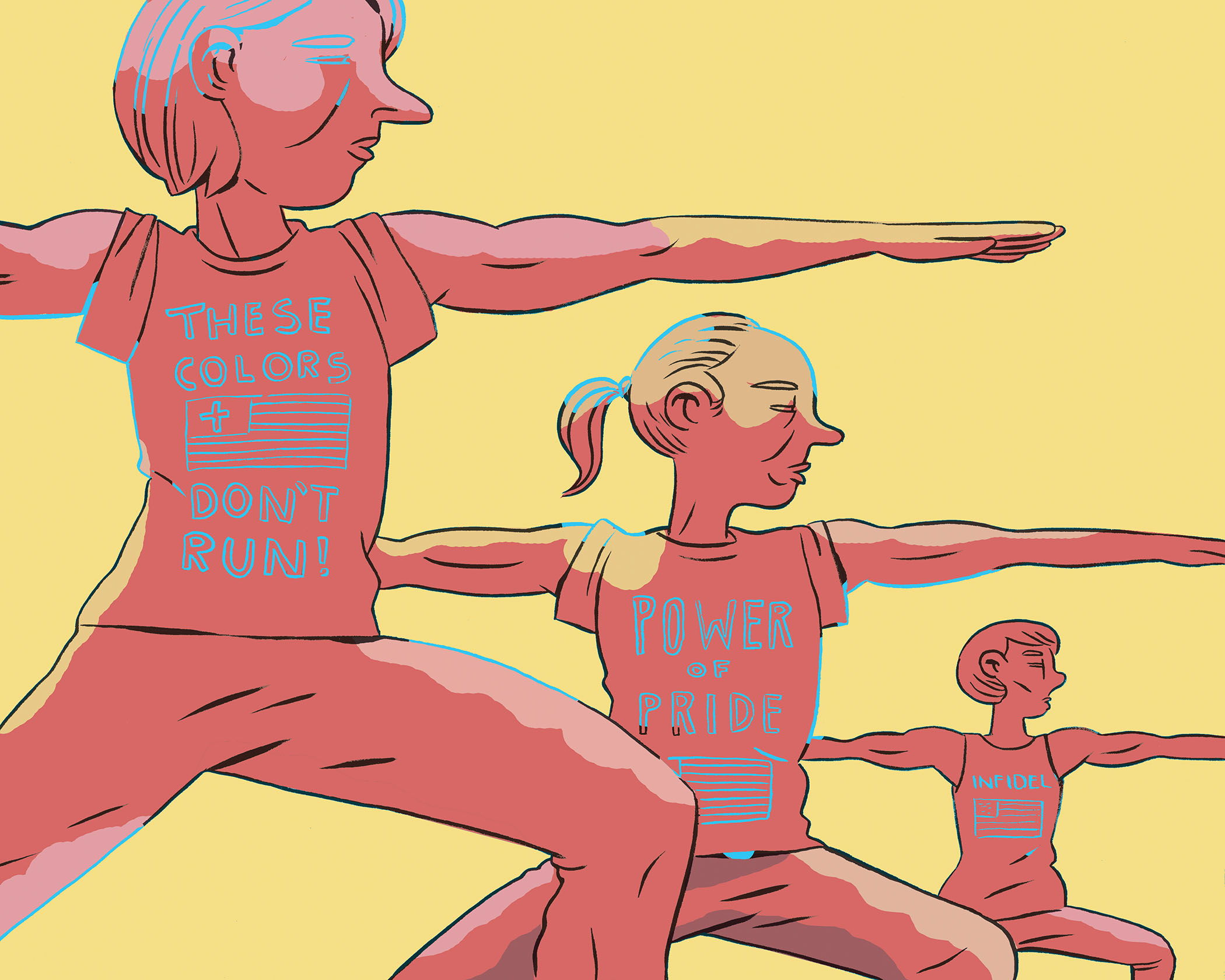Colonisation is to lay claim to another’s land through physical occupation, and, in this possession, to also claim the power of definition over that land by stripping it of its original identity and imposing one’s own identity on it.
This process isn't limited to charging British soldiers and manicured cricket lawns; a white woman on a “Prana E.C.O” yoga mat is also a colonialist force.
People who practice yoga in England and America often neglect to consider the years of British colonial rule in India, and the role that these years necessarily play in making the West’s relationship with yoga not a friendly cultural exchange, but a violent process of colonisation.
Almost all yoga teachers and studio owners in America are white women. A Google search for yoga studios in Portland yields a list of white-owned businesses with catalogues of white woman teachers and galleries of smiling white woman students. Any yoga magazine is filled with the words and bodies of white women. In less white cities than Portland, yoga teachers are still overwhelmingly non-Indian, and mostly white, women. These few non-white yoga teachers in America are a relatively recent phenomenon; almost all of their own teachers have been white.
White women, then, are the people who define and embody yoga in American society; this is the fundamental level on which yoga has been colonised. By rehoming yoga from Indian bodies into white bodies, white people have physically occupied yoga and imposed their identities upon it. These white people teach, and thereby claim the power of narrative over, yoga for Western society. Yoga is told in white voices.
Even the Wii Fit Trainer, ubiquitous in living rooms the world over, and who is many people’s first introduction to yoga, is a white woman.
On these white women’s yoga studios’ websites, they use their white voices to advertise yoga with rhetoric of “lifting our hands and hearts up”, making “small contributions of love and hope”, creating “healing opportunities”, and, over and over again, achieving “peace”.
This story of yoga they have collaboratively created is far removed from the historical Indian understanding of yoga. In the Yoga Sutras of Patanjali,Yoga Sutras of Patanjali, which is widely acknowledged to be one of the most comprehensive compilations on the philosophy of yoga, Patanjali discusses yoga as a Hindu spiritual practice, the ultimate goal of which is moksha, or liberation. He discusses, at length, yoga as discipline over the mind and isolation of the consciousness; he talks, too, about the power that can be accessed through practice of yoga.
The peace-and-healing version of yoga that is marketed in America —divorced from religion, devoid of philosophical roots, embodied in thin white women—is a reductive and misrepresentative copy of what yoga actually is.
It would be naïve not to consider this reduction, this misrepresentation, through a lens of colonial power.
Yoga, which has never been a gendered practice in India, has been heavily feminised by the patriarchal West—in other words, it has been feminised by a people with a heavy contempt for femininity.
In a society where misogyny dictates that women be dominated by men, feminisation is a tool of subjugation, and violent feminisation of native peoples in occupied lands is a time-honoured British and American colonial tradition: British authorities went so far as to seek anthropological legitimacy for the phenomenon in India, writing that the searingly hot climate, along with centuries of racial miscegenation, had "effeminized the native male", especially in the south.
Doing this to yoga clearly situates it, and the Indian identity that it symbolises, in a position to be patriarchally dominated and reshaped by the West.
The feminisation of yoga lends itself to a narrative that, like femininity, is denied any power. Much like the similarly feminised, reduced, romanticised white narrative of Gandhi’s "non-violence," yoga has been branded with un-nuanced ‘peace.’
The decontextualized description of yoga in terms of "peace" and "healing" conspicuously rejects yoga’s philosophical roots of strength, power, and liberation: none of these facilitate colonisation; in fact, they all inhibit it.
This convenient reduction imposes a characterisation of glorified submission upon the colonised, discouraging resistance and reinforcing colonial rule, as well as popular perception of colonial rule.
The relocation of yoga to thin white bodies aestheticizes it by white colonial aesthetic standards; the divorce from Hinduism and all Indian religion and philosophy sanitizes it (one might say bleaches it) to cater to the white colonial palate.Whitewashed, reduced to peace-and-healing, yoga in the West is a marketable, digestible, low-commitment version of what yoga is to the people that it is stolen from.
Yoga has been completely stripped of its power, strength, and glaring Indianness, repackaged into a symbol of contemptible, weak, nonthreatening, submissiveness: exactly what a colonial power looks for in a colony.
This societal understanding of yoga destroys the livelihoods of those who engage in resistance by practicing and teaching the less marketable, less palatable, actual yoga that is the descendant of, and participant in, the correspondingly less marketable, less popular, Indian history and culture.
These people, and the truths that they teach, are suffering economically. They are, as intended by the colonial power, being stamped out by new-age-fitness peace-and-healing yoga.
How can they hope to compete against this image of them that is so much more convenient for everyone else to hold—and that is, moreover, so much easier to listen to because it doesn’t come in a thick Indian accent?
Appropriation is real, continuing colonial violence. People, including people of colour, often talk about how appropriation is the mildest form of racism.
While I do not directly contest that statement, I do believe that the main reason appropriation is treated that way is that it is the least immediate form of racism, and "slow-acting" is easy to mistake for "non-virulent".
The effects of appropriation are never immediately apparent, and that makes it tempting to think about it as a non-threatening and consequently forgivable form of racism, but colonisation is a profound, lasting phenomenon.
The fact that Indian taxes no longer go directly to the queen is no guarantee that the Indian people’s colonisation is over.
It seems almost ludicrous to treat such a well-intentioned phenomenon as an act of colonialist violence, but, as every intention-versus-impact discussion (hopefully) concludes, the fact that there isn't a coordinated effort to violently subjugate does not preclude coordinated violent subjugation.
At the risk of cliché: no snowflake in an avalanche ever feels responsible.
It is, of course, entirely coincidental that snowflakes are white, and the fact that they melt into powerless puddle-stuff under the hot Indian sun is completely irrelevant.

